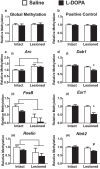Dynamic DNA Methylation Regulates Levodopa-Induced Dyskinesia
- PMID: 27307239
- PMCID: PMC5015786
- DOI: 10.1523/JNEUROSCI.0683-16.2016
Dynamic DNA Methylation Regulates Levodopa-Induced Dyskinesia
Abstract
Levodopa-induced dyskinesia (LID) is a persistent behavioral sensitization that develops after repeated levodopa (l-DOPA) exposure in Parkinson disease patients. LID is a consequence of sustained changes in the transcriptional behavior of striatal neurons following dopaminergic stimulation. In neurons, transcriptional regulation through dynamic DNA methylation has been shown pivotal to many long-term behavioral modifications; however, its role in LID has not yet been explored. Using a rodent model, we show LID development leads to the aberrant expression of DNA demethylating enzymes and locus-specific changes to DNA methylation at the promoter regions of genes aberrantly transcribed following l-DOPA treatment. Looking for dynamic DNA methylation in LID genome-wide, we used reduced representation bisulfite sequencing and found an extensive reorganization of the dorsal striatal methylome. LID development led to significant demethylation at many important regulatory areas of aberrantly transcribed genes. We used pharmacologic treatments that alter DNA methylation bidirectionally and found them able to modulate dyskinetic behaviors. Together, these findings demonstrate that l-DOPA induces widespread changes to striatal DNA methylation and that these modifications are required for the development and maintenance of LID.
Significance statement: Levodopa-induced dyskinesia (LID) develops after repeated levodopa (l-DOPA) exposure in Parkinson disease patients and remains one of the primary obstacles to effective treatment. LID behaviors are a consequence of striatal neuron sensitization due to sustained changes in transcriptional behavior; however, the mechanisms responsible for the long-term maintenance of this cellular priming remain uncertain. Regulation of dynamic DNA methylation has been shown pivotal to the maintenance of several long-term behavioral modifications, yet its role in LID has not yet been explored. In this work, we report a pivotal role for the reorganization of DNA methylation in the development of LID and show that modification of DNA methylation may be a novel therapeutic target for use in preventing or reversing dyskinetic behaviors.
Keywords: DNA methylation; dyskinesia; l-DOPA.
Copyright © 2016 the authors 0270-6474/16/366514-11$15.00/0.
Figures






Similar articles
-
Alternative splicing of AMPA receptor subunits in the 6-OHDA-lesioned rat model of Parkinson's disease and L-DOPA-induced dyskinesia.Exp Neurol. 2013 Sep;247:476-84. doi: 10.1016/j.expneurol.2013.01.019. Epub 2013 Jan 27. Exp Neurol. 2013. PMID: 23360800
-
Differential induction of dyskinesia and neuroinflammation by pulsatile versus continuous l-DOPA delivery in the 6-OHDA model of Parkinson's disease.Exp Neurol. 2016 Dec;286:83-92. doi: 10.1016/j.expneurol.2016.09.013. Epub 2016 Sep 30. Exp Neurol. 2016. PMID: 27697481
-
Dysregulation of BET proteins in levodopa-induced dyskinesia.Neurobiol Dis. 2017 Jun;102:125-132. doi: 10.1016/j.nbd.2017.03.003. Epub 2017 Mar 9. Neurobiol Dis. 2017. PMID: 28286180 Free PMC article.
-
Synaptic plasticity may underlie l-DOPA induced dyskinesia.Curr Opin Neurobiol. 2018 Feb;48:71-78. doi: 10.1016/j.conb.2017.10.021. Epub 2017 Nov 7. Curr Opin Neurobiol. 2018. PMID: 29125979 Free PMC article. Review.
-
The Role of ΔFosB in the Pathogenesis of Levodopa-Induced Dyskinesia: Mechanisms and Therapeutic Strategies.Mol Neurobiol. 2025 Jun;62(6):7393-7412. doi: 10.1007/s12035-025-04720-z. Epub 2025 Jan 31. Mol Neurobiol. 2025. PMID: 39890697 Review.
Cited by
-
Long-Term Hypermethylation of FcγR2B in Leukocytes of Patients with Kawasaki Disease.J Clin Med. 2021 May 27;10(11):2347. doi: 10.3390/jcm10112347. J Clin Med. 2021. PMID: 34071896 Free PMC article.
-
Signal transduction in L-DOPA-induced dyskinesia: from receptor sensitization to abnormal gene expression.J Neural Transm (Vienna). 2018 Aug;125(8):1171-1186. doi: 10.1007/s00702-018-1847-7. Epub 2018 Feb 2. J Neural Transm (Vienna). 2018. PMID: 29396608 Free PMC article. Review.
-
Effects of histone acetyltransferase inhibitors on L-DOPA-induced dyskinesia in a murine model of Parkinson's disease.J Neural Transm (Vienna). 2018 Sep;125(9):1319-1331. doi: 10.1007/s00702-018-1902-4. Epub 2018 Jul 11. J Neural Transm (Vienna). 2018. PMID: 29998409
-
Dnmt3a2/Dnmt3L Overexpression in the Dopaminergic System of Mice Increases Exercise Behavior through Signaling Changes in the Hypothalamus.Int J Mol Sci. 2020 Aug 31;21(17):6297. doi: 10.3390/ijms21176297. Int J Mol Sci. 2020. PMID: 32878077 Free PMC article.
-
The Epigenome as a therapeutic target for Parkinson's disease.Neural Regen Res. 2016 Nov;11(11):1735-1738. doi: 10.4103/1673-5374.194803. Neural Regen Res. 2016. PMID: 28123403 Free PMC article. Review.
References
-
- Biddie SC, John S, Sabo PJ, Thurman RE, Johnson TA, Schiltz RL, Miranda TB, Sung MH, Trump S, Lightman SL, Vinson C, Stamatoyannopoulos JA, Hager GL. Transcription factor AP1 potentiates chromatin accessibility and glucocorticoid receptor binding. Mol Cell. 2011;43:145–155. doi: 10.1016/j.molcel.2011.06.016. - DOI - PMC - PubMed
Publication types
MeSH terms
Substances
Grants and funding
LinkOut - more resources
Full Text Sources
Other Literature Sources
Molecular Biology Databases
